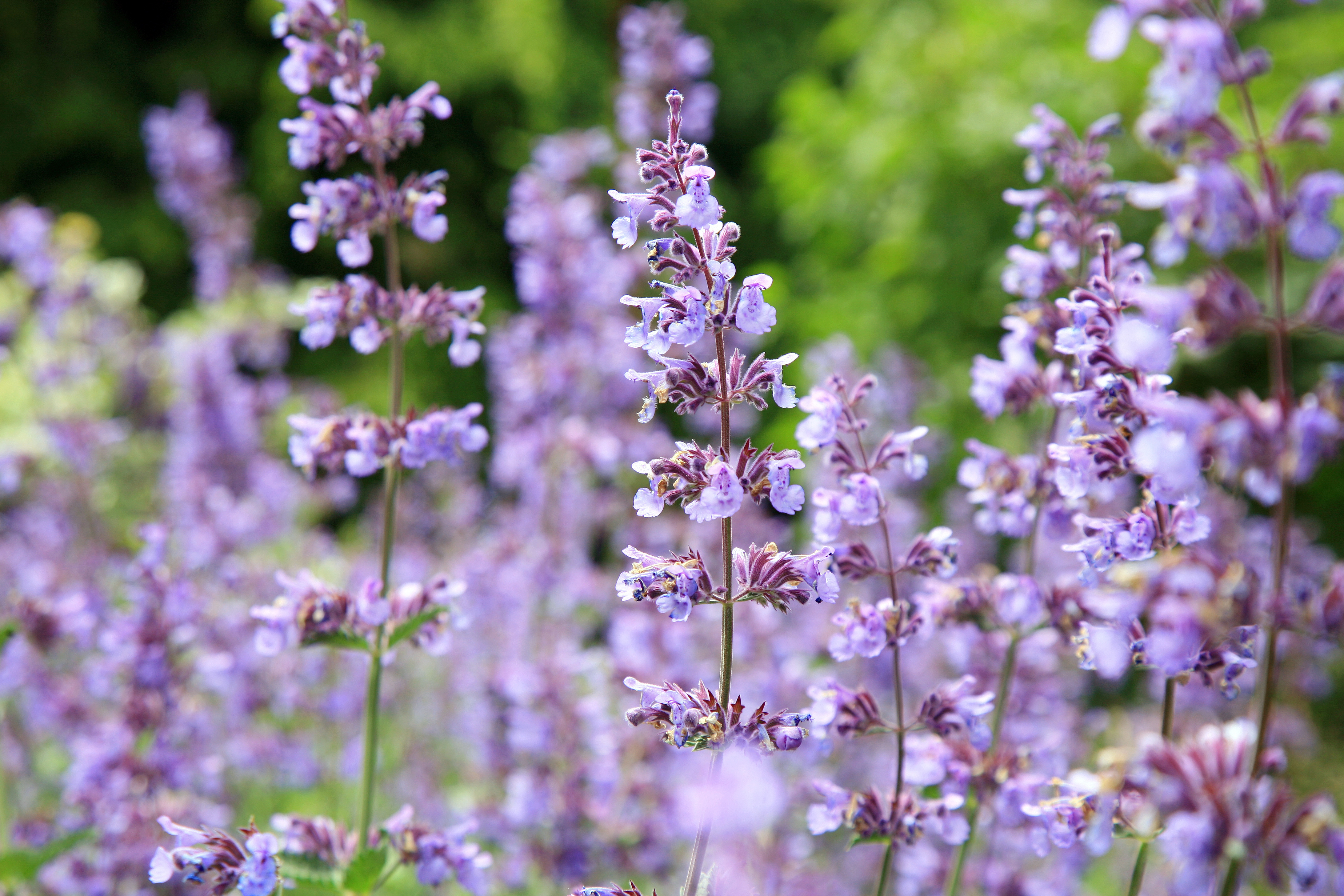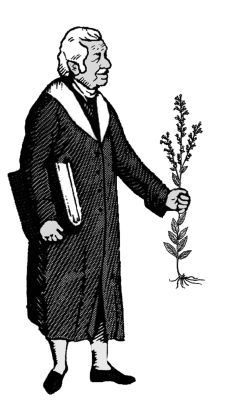Calm With Catnip
Published: Wed, 05/17/17
May 17, 2016
Calm With Catnip Kelly Pomeroy, M.H.
I was sitting out on the porch recently enjoying an evening visit with a friend when I noticed her beautiful catnip plant. I asked if I could have some leaves and after our visit I went home and enjoyed some of the loveliest tea I have had in a long time.

Catnip is an herbaceous perennial with soft greyish green heart shaped leaves and square stems. It is a member of the mint family and has a flavor that is both sweet and mild. Catnip’s common name derives from its Latin name, Nepeta cataria. It is curious that its name contains the word cat because it has an affinity for attracting felines of all types. It is also referred to as catmint or catnep. The smell is said to have a euphoric or exciting effect on cats. They
love to rub in it, lay by it or play with it. While this plant may not have the same effect on us as these felines, one of catnip’s characteristics is that of a nervine, which means it is toning and healing to the nerves. Members of the mint family contain monoterpenes that are chemical constituents commonly referred to as essential oils. These monoterpenes are “often antibacterial, they stimulate digestion, are carminative (expel gas), and are very aromatic. Plants containing these
oils are “warming” to the surface (skin and mucosa) and “cooling” to internal organs, relieving excess blood stagnation.” They are also known to have sedative, expectorant, diaphoretic (cause perspiration), anthelmintic (expel worms) and antispasmodic activity. (Level 1900, Herbal Chemistry) In Dr. Christopher’s book, Herb
Syllabus, he states, “Catnip works to build the adrenal glands in depressed persons and relaxes the exhausted condition. It also helps in morning sickness and is an excellent remedy for preventing miscarriages.” Catnip contains good amounts of the following minerals: potassium, magnesium, sulfur, manganese, phosphorus, chromium and selenium; and good amounts of these vitamins: Vitamin B1, B2, B5, B6, Folic Acid, B12, Choline, Inositol, Paba, Vitamin C and Vitamin H. (Herbs to the Rescue) With all the characteristics of this plant, it is evident to see how calming and beneficial catnip truly is.
Catnip is often used in children’s remedies because it is known for being a gentle healer. Dr. Christopher uses catnip in his children’s formula Kid-E-Col which contains catnip and fennel, to aid in digestion. It is also used in Dr. Christopher’s Stomach Comfort formula and Liver Gallbladder formula. Additionally, Dr. Christopher recommends using catnip tea in his Cold Sheet Treatment as a tea used for a cold enema. This helps the body absorb the liquid and retain it as long as needed and then be able to relax and eliminate when ready. Catnip is a preferred tea for these purposes because it is a gentle nervine and nutrient rich.
Another wonderful characteristic about catnip is that it has been studied and found to act as a potent mosquito repellant that is just as effective as Deet, but 10 times less toxic due to the monoterpene nepetalactone contained therein. (Chemical Composition and Antimicrobial... Nepeta cataria…) Making a solution of catnip to use as a repellant, I would refer you to a book called The Herbal Medicine-Maker's Handbook by James Green. He uses a process to make a hydrosol, a solution that extracts the oils and some of the water of the plant in a safer and more concentrated amount. This can be used to spray onto the skin topically. Note that the oils are most concentrated in the flowering tops of catnip when choosing to make a hydrosol. In Mrs. Grieves book, A Modern Herbal, it was
stated that rats also dislike the catnip plant and that it can be planted near crops to drive rats away. I might add, and plant it by your house!
Before black tea was imported to England from China, Catnip used to be their tea of choice, which they said was quite as pleasant and a good deal more wholesome.”(A Modern Herbal)
France has been known for using the leaves and young shoots for seasoning as well. Dr. Christopher has listed in his Herb Syllabus book two recipes using catnip included below.
Catnip is grown easily in any garden soil. It is a low maintenance plant that doesn’t need a lot of water. I'd try adding this beauty to your garden or at least to your cupboard in the dried form. Wishing you health, happiness, and calm with catnip!
Kelly Pomeroy is a certified Master Herbalist and Student Adviser for the School of Natural Healing. She loves being a mom to her four awesome kids and is back to school earning a Bachelor's in Biology.
Printable Version: http://herballegacy.com

May 26-27
Tickets and Information

Register Here!
Join us at the Immune Defense Summit!

David Christopher will be speaking on "Protecting Immunity - Effective herbal Remedies"
Register here!
David Christopher is now on Twitter!
You can follow David @DChristopherMH

1 lb. zucchini
2 ounces of olive oil
½ ounce fresh catnip, finely chopped
Wash the zucchini and trim off the ends. Slice the zucchini and sauté in the olive oil in a heavy frying pan. Season, then cover and cook until tender. Before serving, sprinkle with catnip.
Grapefruit and Catnip Dessert
2 medium grapefruit
4 ounces honey
1 teaspoon chopped catnip
1 ½ pints cold water
Peel off the grapefruit rind very thinly, taking care to avoid the white pith. Put into a blender. Remove pith and discard. Coarsely chop the grapefruit flesh and add to blender with the honey, Catnip, and cold water. Blend until the mixture is light green. Strain into stemmed glasses and refrigerate until well chilled. Garnish with a sprig of Catnip.
Both recipes can be found in Herb Syllabus by Dr. John R. Christopher, (Dawson).
Herbal Resource Links
- Herbal Legacy - http://www.herballegacy.com - Our free information website
- The School of Natural Healing - http://www.snh.cc - Quality Education since 1953
- Christopher Publications - http://www.christopherpublications.com - Dr. Christopher's books and more
- Christopher Websites - http://www.christopherwebsites.com - Find all Christopher websites and other great resources
- A Healthier You Radio Show - http://www.ahealthieryouradio.com - Free weekly radio show
The School of Natural Healing: http://www.snh.cc
Christopher Publications: http://www.christopherpublications.com
NOTICE: All information in this newsletter is given out as information only and is not intended to diagnose or prescribe. For our official Disclaimer, Biological Individuality, Important Notice & Terms of Use please see: http://www.herballegacy.com/Disclaimer.html
This newsletter is sent by permission only - you can unsubscribe quickly and easily by clicking the link below.
.

